Add this eBook to your basket to receive access to all 301 records. Our indexes include entries for the spelling piercy. In the period you have requested, we have the following 301 records (displaying 241 to 250): These sample scans are from the original record. You will get scans of the full pages or articles where the surname you searched for has been found. Your web browser may prevent the sample windows from opening; in this case please change your browser settings to allow pop-up windows from this site. Women Students Entering Stockwell Teacher Training College
(1897)
This list, revised to August 1908, gives the student's name and her then address (if known); the Remarks column indicates whether she left the course early; left the profession; went abroad; died; became a headmistress; and/or married: married name is often given. | Sample scan, click to enlarge

| Officers of the Royal Navy and the Royal Marines
(1898)
The Navy List, published by Authority, corrected to 18 December 1898, has this list of the officers on the Active List of the Royal Navy and the Royal Marines. Each officer's surname, christian name, and any middle initial(s) is given; with rank, date of seniority in that rank, and 'where serving', the last being the number of his ship. The ranks are: A, Admiral; A E, Assistant Engineer; A F, Admiral of the Fleet; A P, Assistant Paymaster; Art E, Artificer Engineer; As Ck, Assistant Clerk; B, Boatswain; Bandr, Bandmaster Royal Marines; C, Captain; Car, Carpenter; Ch, Chaplain; Ch B, Chief Boatswain; Ch Cr, Chief Carpenter; Ch E, Chief Engineer; Ch Gr, Chief Gunner; Ch P; Paymaster-in-Chief; Ck, Clerk; Cr, Commander; D I H, Deputy Inspector-General of Hospitals and Fleets; E, Engineer; E Ins, Inspector of Machinery; F E, Fleet Engineer; F P, Fleet Paymaster; F S, Fleet Surgeon; Gr, Gunner; H Sch, Head Schoolmaster; I H, Inspector-General of Hospitals and Fleets; L, Lieutenant; Mid, Midshipman; N C, Naval Cadet; N I, Naval Instructor; P, Paymaster; R A, Rear Admiral; S, Surgeon; S C, Staff-Captain; S Cr, Staff Commander; S E, Staff Engineer; S L, Sub-Lieutenant; S P, Staff Paymaster; S S, Staff Surgeon; Schm, Schoolmaster Royal Marines; St Ma, Sergeant Major Royal Marines; V A, Vice Admiral; W O, Warrant Officer Royal Marines. The column 'Where serving' also may have these abbreviations: AdC, Aide-de-Camp to the Queen; AO, Clerk to Secretary to a Flag Officer; CG, Coast Guard; CGP, Coast Guard Pension; DY, Dock Yard; GH, Greenwich Hospital; GHP, Greenwich Hospital Pension; GSP, Good Service Pension; NH, Naval Hospital; NID, Naval Intelligence Department; NP, Naval Pension (late Out-Pension of Greenwich Hospital); PW, Pension for Wounds; Sec, Secretary to a Flag Officer; TP, Travers Pension; TS, In the Transport Service; VY, Victualling Yard.
| Sample scan, click to enlarge
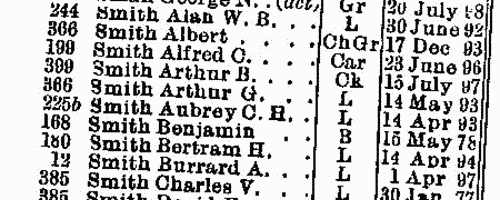
| Boys at University College School
(1860-1900)
In 1830 a school was set up adjoining the University and College of London on Gower Street; the school was enlarged from 1860 to 1876, and then removed to Frognal in 1907. In 1931 this register was published, listing all boys entering the school from Christmas term of 1859 to the summer entrants of 1931. The dates are abbreviated (98-01 = 1898-1901, &c.), each session being reckoned as beginning in September of one year and ending in the July of the next; the date of joining the school is indicated by the former, although it may fall in the latter, but the date of leaving by the latter, although it may fall in the former. Thus, if a boy came at any time during the Session 1863-64 and left any time during 1868-69, his date would be given 1863-69. The boys are listed alphabetically by surname, and then chronologically under each surname, full name being given where known. An asterisk * indicates that that particular boy lost his life in the Great War: in these cases, rank and regiment have been given where possible. Addresses as of 1931 are given where known. Italics in christian names or initials indicate that that particular boy was known, in 1931, to be dead. (a) (b) &c placed before christian names indicates brothers. In some cases occupation in later life is shown (A, artist; B, barrister; C A, chartered accountant; Ch, chemist; E, engineer; H C S, home civil service; I C S, Indian civil service; Med, physician or surgeon; M S E, member of the Stock Exchange; Mus, musician; Rev, minister of religion; S, solicitor). This is the index to those boys who were at the school in the period 1860 to 1900. | Sample scan, click to enlarge

| Long-Lost Relatives: Home Inquiries
(1900)
Each issue of Lloyd's Weekly News, of London, contained a column devoted to searches for Long-Lost Relatives. The inquiries were arranged in three groups: Home Inquiries (i. e., from correspondents in the United Kingdom); Colonial and Foreign Inquiries (from abroad); and Soldiers' and Sailors' Inquiries. Results from all these were grouped together as 'Answers to Inquiries'.
Each column was headed: 'Correspondents MUST give full addresses and the DATES OF THE INQUIRIES to which they refer. We cannot search back numbers, nor print inquiries for "missing husbands." These columns are not intended for inquiries in respect to claimants for money, and no agents, at home or abroad, have any connection with Lloyd's.' | Sample scan, click to enlarge

| Unclaimed Naval Prize Money
(1855-1902)
Various prize moneys were awarded to officers and men who served on board her Majesty's ships. For one reason or another a substantial number of these prizes, from as little as a shilling or two to as much as many pounds, remained undistributed by 1902, when this comprehensive list of the unclaimed moneys was printed: it lists unclaimed shares of prize money, slave and pirate bounties, salvage awards, parliamentary grants, gratuities and other moneys distributed by the Admiralty 1855 to 1902, but which omits moneys for service on the China Station during the war of 1856 to 1880, and special gratuities for service in Egypt (1882), Soudan (1884) and Soudan and Nile Expedition (1884-1885), for which there are separate indexes. In each case the sailor's name is given first (surname, then christian name or initials); rank or rating; ship in which serving at time of capture or award; and the amount due. | Sample scan, click to enlarge

|  British artillerymen fighting in South Africa
(1899-1902) British artillerymen fighting in South Africa
(1899-1902)
The Queen Victoria's South Africa Medal was awarded (after her death, in the event) to all who had served honourably in the various campaigns in the Boer War. Returns were made from each unit, and consolidated into nominal roll, of which this is the one for the Royal Artillery. Confusingly, the ledgers used had originally been printed for a register of men transferred (or re-transferred after mobilization) to 1st Class Army Reserve. All the original column headings were therefore struck through, and the roll was prepared with this information: Date of Issue; Regimental Number; Rank; Name; Unit; Medal (a 1 indicating that a medal was awarded); [number of] Clasps; the reference to the source in the original returns, usually starting with AG for papers in the hands of the Adjutant-General, and 68/Art/ for the Royal Artillery records. The final column, normally left blank, was occasionally used for explanatory remarks. | Sample scan, click to enlarge

| Lieutenants of the Royal Navy
(1904)
The Monthly Naval List for November 1904, printed By Authority for the Admiralty, contains this List of Officers on the Active List of the Royal Navy with the Dates of their Seniority. The list is arranged by rank, and then by date of seniority: full names, including full middle names, are given. Each name is preceded (where appropriate) by the number of the ship in which serving; an 'm' indicating the holder was entitled to wear a medal; one or more asterisks for officers authorized to hold foreign orders. (C) after the name denotes an officer who had obtained his lieutenant's commission by competition at the Royal Naval College; (E) one who had obtained the same for meritorious examination there; or (G) one who had received an honorary certificate or had qualified as a Gunnery or Torpedo Lieutenant. There are also various sets of initials in italics indicating: AdC Aide-de-Camp to the King, AO Clerk to Secretary to a Flag Officer, CG Coast Guard, CGP Coast Guard Pension, Coll studying at Naval College, Dev an acting sub-lieutenant studying at Devonport, DY Dock Yard, GH Greenwich Hospital, GHP Greenwich Hospital Pension, GSP Good Service Pension, KHC Honorary Chaplain to the King, KHP Honorary Physician to the King, KHS Honorary Surgeon to the King, NH Naval Hospital, NID Naval Intelligence Department, NP Naval Pension, Po an acting sub-lieutenant studying at Portsmouth, PW Pension for Wounds, RNVR Royal Naval Volunteer Reserve, SC undergoing short course of instruction in torpedo, gunnery, &c., ScM Royal Naval School of Music, Sec Secretary to a Flag Officer, TB Torpedo Boat, TP Travers Pension, TS Transport Service, VY Victualling Yard. Large or bold letters in brackets or circles indicate qualifications in - G gunnery, I interpreting, N navigating, S secretary, T torpedo. There are lists for Flag Officers (Admirals of the Fleet, Admirals, Vice-Admirals, and Rear Admirals); Captains; Commanders; Lieutenants; Supplementary Lieutenants; Sub-Lieutenants (with class of their certificates in seamanship, navigation, pilotage, gunnery and torpedo); Midshipmen; Navy Cadets; Staff Captains; Engineer Rear-Admirals; Engineer Captains; Engineer Commanders; Engineer Lieutenants; Engineer Sub-Lieutenants; Chaplains (where these also acted as Naval Instructors, their seniority in that appointment is given as well); Naval Instructors (where these also acted as Chaplains, their seniority in that appointment is given as well); (Medical) Inspector-Generals of Hospitals and Fleets; Fleet Surgeons; Staff Surgeons; Surgeons; Paymasters-in-Chief; Fleet Paymasters; Staff Paymasters; Paymasters; Assistant Paymasters; Clerks; Assistant Clerks; Carpenter Lieutenants; Chief Gunners; Gunners; Chief Boatswains; Boatswains; Chief Signal Boatswains; Signal Boatswains; Chief Carpenters; Carpenters; Chief Artificer Engineers; Artificer Engineers; Chief Schoolmasters; Head Schoolmasters; Head Wardmasters. | Sample scan, click to enlarge
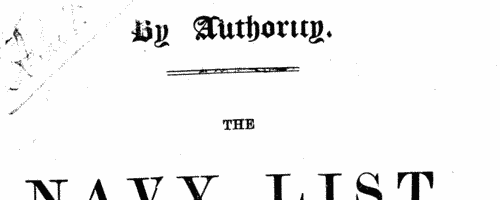
| Officers of H. M. S. Juno, Home Fleet
(1904)
The Monthly Naval List for November 1904, printed By Authority for the Admiralty, contains this List of Ships and Vessels of the Royal Navy with their Officers and Present Stations. The number after the name of the ship denotes the number of guns of 4-inch calibre and upwards. The tons represents the displacement tonnage. A letter P. in bold denotes Paddle Wheel; S. Single Screw. The italic abbreviations are F. D. Forced Draught; I. H. P. Indicated Horse Power; N. D. Natural Draught. All officers whose names are in italics are borne as supernumeraries or additions. (G) against an officer's name denotes that he is borne for gunnery duties; (N) navigating; (T) torpedo. In the cases where two dates are shown against the names of marine officers, the date in brackets is that from which his present sea time commenced. | Sample scan, click to enlarge
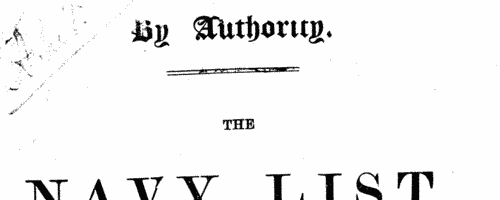
| Officers of the Royal Naval Reserve
(1904)
The Monthly Naval List for November 1904, printed By Authority for the Admiralty, contains this List of Officers on the Active List, and of Honorary Officers of the Royal Naval Reserve. The list gives names, rank and seniority. The names may be preceded by an asterisk, for those who had completed 12 months' training in the Royal Navy; a further asterisk for 12 months' more service; a dagger for a certificate in a gunnery or torpedo short course; a double dagger for certificates in both. The abbreviations for rank are: A E, assistant engineer; A P, assistant paymaster; Cr, commander; E, engineer; L, lieutenant; Mid, midshipman; P, paymaster; S L, sub-lieutenant; S P, staff paymaster; Sen E, senior engineer; W E, warrant engineer. | Sample scan, click to enlarge
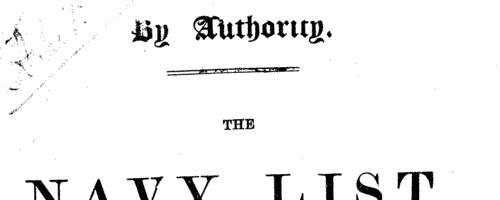
| Officers of the Royal Navy
(1904)
The Monthly Naval List for November 1904, printed By Authority for the Admiralty, contains this Alphabetical List of the Officers on the Active List of the Royal Navy and the Royal Marines with the Dates of their Seniority. The first column 'Where serving' gives the number of the ship; the second column gives full name, surname first, but with middle names represented only by initials; the third column rank; and the fourth column seniority, i. e., the date of attaining that rank. Lieutenants whose seniorities are printed in italics are on the Supplementary List, and Engineer Lieutenants whose seniorities are printed are those not yet advanced. | Sample scan, click to enlarge
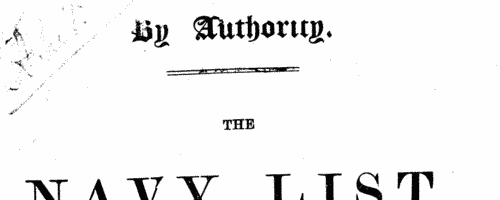
|
Research your ancestry, family history, genealogy and one-name study by direct access to original records and archives indexed by surname.
|












